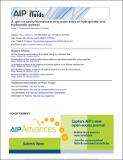A spin on cavity formation during water entry of hydrophobic and hydrophilic spheres
Author(s)
Truscott, Tadd T.; Techet, Alexandra H.
DownloadTechet-2009-A spin on cavity.pdf (858.4Kb)
MIT_AMENDMENT
MIT Amendment
Article is made available in accordance with the publisher's policy and may be subject to US copyright law. Please refer to the publisher's site for terms of use.
Terms of use
Metadata
Show full item recordAbstract
Surface coating and impact velocity can dramatically affect cavity formation during water entry of spheres. Duez et al. [Nat. Phys. 3, 180 (2007) ] present a theoretical limit, dependent on impact velocity and surface static wetting angle, below which air cavities no longer form. We show that transverse spin alters the spheres surface velocity distribution to straddle this theoretical limit, resulting in cavity formation over half of the sphere and none on the other half, and yields similar results to the case of a sphere dropped without spin, at the same impact speed, when its surface is half hydrophilic and half hydrophobic.
Date issued
2009-12Department
Massachusetts Institute of Technology. Department of Mechanical EngineeringJournal
Physics of Fluids
Publisher
American Institute of Physics
Citation
Truscott, Tadd T., and Alexandra H. Techet. “A spin on cavity formation during water entry of hydrophobic and hydrophilic spheres.” Physics of Fluids 21 (2009): 121703.© 2009 American Institute of Physics.
Version: Final published version
ISSN
1070-6631
1089-7666